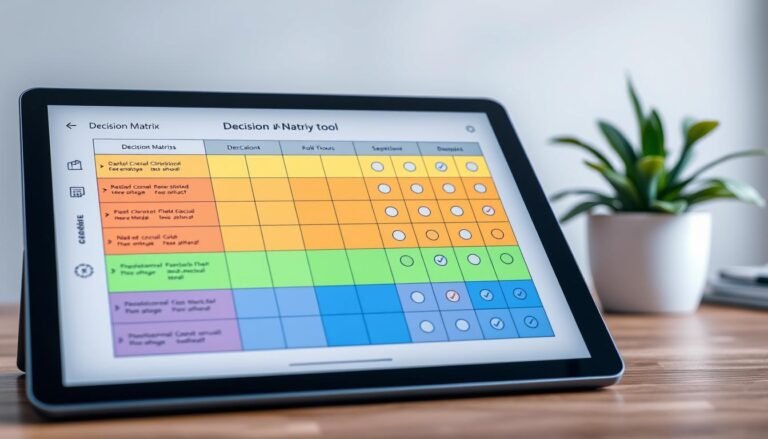Master Scenario Planning for Strategic Success
Have you ever thought about why some companies do well even when things are uncertain? It might be because they use Scenario Planning. This method helps them see the future and stay strong. In today’s fast-changing market, getting the future right is key. This article will show how companies can handle uncertainty by planning for different futures.
Key Takeaways
- Scenario Planning addresses common strategic errors of overprediction and underprediction.
- It encompasses identifying trends and driving forces for accurate future analysis.
- An effective process involves brainstorming scenarios and evaluating uncertainties.
- Key factors like technology, competition, and political conditions play a vital role.
- Regular updates and evaluations of strategies are necessary to adapt to market dynamics.
- Successful Scenario Planning enhances decision-making and increases organizational resilience.
Understanding Scenario Planning
Scenario Planning is a way for companies to plan for the future by looking at different possible outcomes. It’s a key tool for making better business decisions. By thinking about what might happen, companies can spot chances and risks. This helps them plan better for the future and stay flexible.
What is Scenario Planning?
Scenario Planning means picking out key forces and uncertainties in a company. It focuses on 2 to 4 big uncertainties to keep strategies simple. This approach helps teams work together better and solve problems creatively. It also makes sure plans are clear and easy to understand.
Historical Background and Evolution
Scenario Planning started during the Cold War, when military analysts made scenarios for possible nuclear war outcomes. This idea has spread to many fields, like farming and transport. By the 1960s, it became popular in the oil industry, making companies better at handling change.
Importance in Today’s Business Landscape
Nowadays, scenario planning is crucial for dealing with fast changes. Companies use it to predict and prepare for things like economic changes, new tech, or shifts in what customers want. This planning helps manage risks and adapt quickly to new challenges. Companies that plan ahead can stay ahead and grow stronger.
The Scenario Planning Process
The Scenario Planning Process is key for businesses to handle future uncertainties well. It involves a detailed approach for strategic analysis. This helps companies predict different outcomes and adjust as needed. Here are the main steps of this process.
Step-by-Step Overview
Effective scenario planning needs a step-by-step approach that can take weeks to months. Companies should explore different planning methods to spot key uncertainties. Then, they create possible scenarios. The first steps are:
- Identifying Critical Uncertainties: It’s vital to spot things like economic changes or new tech to shape future scenarios.
- Gathering Data: Using PESTLE analysis helps find forces that affect companies.
- Crafting Scenarios: Make several scenarios based on the uncertainties to be ready for different futures.
- Discussing Implications: Talk with stakeholders to see how different scenarios could affect decisions.
Key Components of Effective Scenario Planning
For scenario planning to work well, some key parts are important:
- Critical Uncertainties: Picking two uncertainties with big impacts is key for good scenario making.
- Engagement: Getting stakeholders involved helps with teamwork and better results.
- Integration: Adding scenario planning into a company’s overall strategy and vision helps everyone work together.
- Adaptation: Changing strategies and operations based on scenarios keeps businesses flexible in a changing world.
Companies like the U.S. military and Royal Dutch/Shell Oil Company use these ideas well in their planning. This shows how scenario planning works well in different areas.
Identifying Trends and Driving Forces
Identifying trends and forces is key to good scenario planning. It helps organizations understand their environment better. This way, they can use their strengths well and react quickly to market changes.
Recognizing External Factors
External factors greatly shape an organization’s strategy. These include things like the economy, laws, new tech, and changes in population. By spotting these trends, companies can prepare for what’s coming.
Talking to customers and suppliers gives deeper insights. This helps in making smart decisions and planning for different scenarios.
Assessing Internal Capabilities
What a company can do is its core strength. It’s about knowing what resources and skills you have. Looking at past successes and current strengths helps use outside forces well.
This deep look inside helps make realistic plans. It makes sure the company is ready for surprises.
Evaluating Market Dynamics
Market dynamics affect how businesses work. They include things like competition, how customers behave, and what’s currently popular. Knowing these things is key to seeing what might change the game.
By looking at competitors and new players, companies can spot big changes. This helps in making plans for the future and staying flexible with market shifts.
Developing Scenarios and Templates
Creating effective scenarios and templates for planning is key. These tools help us think in a structured way. They let us see many possible futures by analyzing trends and forces. With 28 free templates, professionals can pick what fits their needs best.
Templates come in many forms, like stories, probability frameworks, and plans for specific events. They help business leaders, project managers, and financial experts build detailed stories. These stories show the best, worst, and most likely scenarios. This method helps companies plan for different situations, making them ready for action.
These templates have important features that make them work well. They include:
- Storytelling to make scenarios easy to understand
- Probability assessment for a clear idea of what might happen
- Impact scales to see how scenarios could affect us
- Mitigation strategy planning to prepare for risks
- SWOT analysis integration for a balanced strategy
- Data-driven insights for making smart choices
These templates help different people in a company, like those making big decisions, analyzing data, or ensuring rules are followed. For example, a financial scenario template is great for CFOs to understand how the market affects their finances. Operational risk templates help risk managers spot and prepare for daily operation disruptions.
In summary, making scenarios with specific templates uses data well. It helps navigate uncertain markets and links strategic plans with real actions. By looking at different scenarios, businesses can be ready for challenges and opportunities.
| Template Type | Best For | Key Features |
|---|---|---|
| Narrative Business Scenarios | Corporate Storytellers | Engaging storytelling, visual context |
| Probability-Based Template | Strategic Planners | Quantifiable outcomes, assessed risks |
| Operational Risk Template | Risk Managers | Impact assessment, mitigation strategies |
| Financial Scenario Analysis | CFOs and Financial Analysts | Market impact analysis, quantitative insights |
| Scenario Analysis XY Axis | Data Analysts | In-depth comparative analysis, variable focus |
Evaluating and Adapting Scenarios
In today’s fast-changing business world, it’s key to regularly check and adjust plans. Companies need to mix creative thinking with careful analysis. This mix keeps plans up-to-date and useful.
Being creative helps bring new ideas to the table. But, analyzing these ideas with facts makes sure they work. This way, teams can see the good and bad of different plans and spot things they might have missed.
Balancing Creativity and Systematic Analysis
Good planning involves hearing from many people. This teamwork helps make plans that can change with the market. Companies that think creatively can handle surprises better.
They keep improving their plans by listening to feedback. This keeps their goals in line with what’s happening now and what they want for the future.
Using Data to Forecast Outcomes
Data is key to making good plans. By using numbers, research, and current data, companies can check if their plans make sense. For instance, they can use financial models to see the best and worst cases.
Tools like Decision Trees help make clear choices and predict outcomes. Using data helps make better decisions and supports quick changes as things change.
Benefits of Scenario Planning for Businesses
Scenario planning is a key strategy for companies. It boosts their strategic planning and overall performance. It helps businesses make better decisions and improve their strategies.
Enhancing Decision-Making
Scenario planning helps improve how companies make decisions. It offers different possible outcomes, giving leaders tools to look at various strategic choices. This method leads to deep discussions about the pros and cons of each decision.
This makes decisions clearer and more in line with long-term goals.
Boosting Business Resilience
Scenario planning makes businesses more resilient. Being ready for different futures helps them adapt quickly to surprises. This reduces the harm from sudden events.
Having plans for many scenarios keeps operations running smoothly in crises. When people feel a company is ready for anything, they trust it more.
Implementing Contingency Plans
Good contingency planning is key to scenario planning success. The insights from scenario development help make plans for unexpected problems. These plans are vital for making quick decisions.
Training staff on these plans helps them stay calm and work well even in tough times.
Risk Management and Scenario Planning
Combining risk management with scenario planning helps organizations deal with uncertainties better. By tackling potential risks ahead of time, companies can make their strategies stronger. This way, they can handle unexpected challenges well.
Mitigating Uncertainties
Scenario analysis lets companies see what problems might happen. Knowing what drives these uncertainties helps in managing risks well. With good scenario planning, companies stay ready for both normal and extreme situations. This makes them more resilient.
Creating Backup Strategies
Having backup plans is key to keeping things running smoothly in tough times. By making scenario contingency plans, companies can have other ways to go when things don’t go as planned. This shows that the company is ready to keep going, no matter what.
Embedding Flexibility in Business Strategies
Being flexible is vital in today’s fast-changing world. Scenario planning helps create plans that can quickly change with the market. This flexibility helps achieve long-term goals and respond quickly to sudden changes.
| Scenario Planning Strategies | Description | Benefits |
|---|---|---|
| Multi-level Driver-Based Analysis | Analyzes multiple interrelated factors and their impacts. | Provides a comprehensive view of potential outcomes. |
| Single Variable Sensitivity Analysis | Focuses on the impact of changing a single variable. | Helps organizations understand critical factors affecting outcomes. |
| Initiative-Based Scenario Planning | Develops scenarios based on specific initiatives or projects. | Aligns scenarios with strategic objectives and initiatives. |
This approach to risk management and scenario planning builds a culture of being ready and prepared. It leads to better decision-making and makes organizations more resilient.
Conclusion
Mastering scenario planning is key for companies aiming for success in a changing business world. Companies like Royal Dutch Shell started using it in the 1970s. This method helps leaders make better decisions by preparing for different future scenarios.
Creating possible scenarios helps predict market changes, like sudden oil price hikes. This approach improves a company’s ability to adapt quickly, make strong decisions, and stay confident.
By using a strategic plan that includes knowing who matters and what uncertainties are key, businesses can get ready for challenges. Scenario planning has become even more important after the Covid-19 pandemic. It shows the need for flexible strategies in today’s complex world.
In summary, scenario planning boosts a company’s long-term strategy and helps it stay strong and competitive. Companies that use scenario analysis in their planning are better prepared to handle market changes. They can face new challenges with confidence and creativity.
Source Links
- A step-by-step Guide to Scenario Planning
- Scenario Planning (Online): Learn How to Model, Predict, and Prepare for the Future
- What is Scenario Planning and How to Use It
- Scenario Planning
- Understand Scenario Planning for Strategic Success
- The 4-Step Scenario Planning Process (with Examples)
- Scenario Planning | GLISA
- Scenario Planning
- Scenario planning: strategies, techniques, & examples [2024]
- Scenario Planning Made Simple: An 8-Step Method
- 28 Free Scenario Planning Templates: All Format, Editable
- Free Scenario Planning Templates: Excel, MS Word, PPT & PDF
- How do you evaluate and monitor the effectiveness of scenario planning?
- Scenario-Based Climate Change Adaptation Showcase – Climate Change (U.S. National Park Service)
- Scenario Planning: Advantages, Disadvantages, and Strategy
- The Benefits of Scenario Planning
- Scenario planning advantages and disadvantages – Profit Frog
- How to Improve Risk Management Through Scenario Planning
- Step-by-Step Guide to Scenario Planning in Risk Management – IRM India Affiliate
- Using Scenario Planning to Surface Invisible Risks (SSIR)
- Scenario Planning: Preparing for the Future Today — Bâton Global
- What is scenario planning and how to use it
- The Power of Scenario Planning in Strategic Decision-Making







